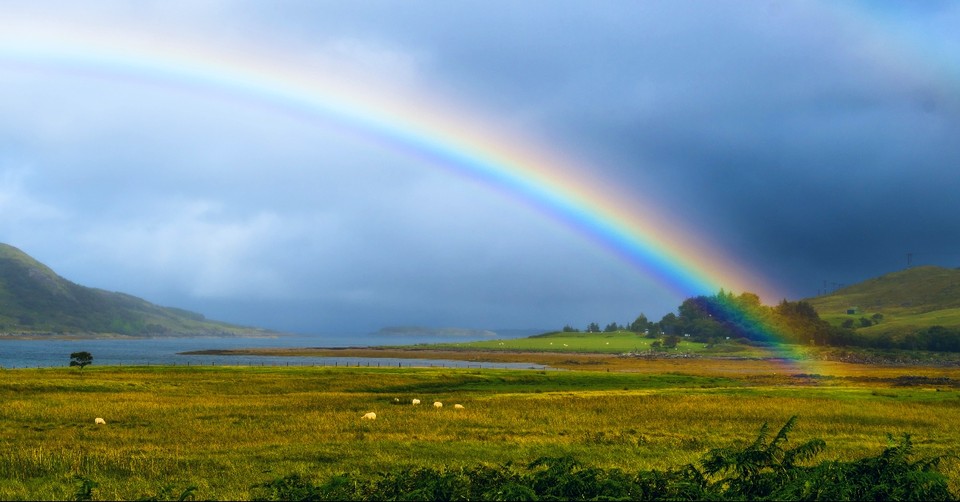What Is the Meaning of the Rainbow in the Bible?

It is intriguing that so many myths explain the rainbow as some sort of supernatural “bridge,” because the most important theme that the rainbow illustrates for us is God’s gracious and grand purpose of redemption to give humanity a chance to start again.
Table of Contents
- Introduction: The Awe of the Rainbow
- The World's View of the Rainbow
- The True Meaning of the Rainbow in the Bible
- God's Promises Symbolized by the Rainbow
- The Rainbow Reminds Us of the Gospel
Introduction: The Awe of the Rainbow
Most of my days are filled with mundane events and scenarios. Sometimes something noteworthy takes place, but normally I am seeing and doing what I have seen and done hundreds, if not thousands of times. However, every now and then something extraordinary takes place, prompting me to stand still and be in awe.
One example of this kind of remarkable event would be the appearance of a rainbow in the sky. I do not think I have ever witnessed the appearance of a rainbow where someone did not point up to the sky and say, “Look, a rainbow!” And typically, the brighter and more colorful the rainbow is, the louder people, including myself, cheer over it.
The World's View of the Rainbow
As beautiful and unique as a rainbow is, there is a simple, non-miraculous explanation for this phenomenon. Scientists have known for a long time that rainbows appear when raindrops act as “tiny prisms.”
White light from the sun shines on one side of a water droplet, gets reflected off the other side of the droplet, and then exits out to the other side of the sky as a circular bow or arc of color that is refracted or broken up into the color spectrum.
Rainbows contain a continuum of around 1 million colors that are indistinguishable with the human eye. Instead, we can only really see seven color hues: Red, orange, yellow, green, blue, indigo, and violet.
In fact, a rainbow is not much more than an “optical illusion” that only appears when a viewer is looking from just the right angle relative to the light source.
Nevertheless, the beauty and mystical appearance of the rainbow has caused it to be part of different myths among many cultures around the world. For example, the Norse saw it as a Bifrost “bridge” for gods to cross from earth to their home called Asgard.
Similarly, ancient Japanese believed that rainbows allowed their deceased ancestors to come back to earth, and the Navajo believed that it was the path for holy spirits. Even today, there is an old Irish legend commonly told (often jokingly) that there is a pot of gold at the end of every rainbow guarded by a tricky leprechaun.
Because the devil is the “father of lies” (John 8:44), all of the myths about rainbows are mistruths that distract us from discovering the true symbolic meaning behind it.
The True Meaning of the Rainbow in the Bible
So, what is the true meaning of the rainbow? To answer that question, we must look beyond the children’s coloring books and really weird movies to the Bible — the only truly infallible, inspired, and authoritative source of truth that we have.
The rainbow first appears in Scripture toward the end of the story of the worldwide flood in Genesis 6-9. Because of the continual evil and wickedness of mankind (Genesis 6:5-12), God decided to cause rain to fall for 40 days and nights and flood the entire earth — killing everyone and everything except for a man named Noah and his family and a bunch of animals that were kept safe inside of a wooden ark.
God's Promises Symbolized by the Rainbow
After the floodwaters receded and Noah could get out of the boat onto dry land, he built an altar and offered a burnt offering to God. In response, God declared this promise to Noah and his family:
“Behold, I establish my covenant with you and your offspring after you, and with every living creature that is with you, the birds, the livestock, and every beast of the earth with you, as many as came out of the ark; it is for every beast of the earth. I establish my covenant with you, that never again shall all flesh be cut off by the waters of the flood, and never again shall there be a flood to destroy the earth… This is the sign of the covenant that I make between me and you and every living creature that is with you, for all future generations: I have set my bow in the cloud, and it shall be a sign of the covenant between me and the earth. When I bring clouds over the earth and the bow is seen in the clouds, I will remember my covenant that is between me and you and every living creature of all flesh. And the waters shall never again become a flood to destroy all flesh. When the bow is in the clouds, I will see it and remember the everlasting covenant between God and every living creature of all flesh that is on the earth” (Genesis 9:8-16, ESV).
The Rainbow Reminds Us of the Gospel
And it is great news for us as well because this story clearly and beautifully points us to the time when God sent his own Son, Jesus, to die on a cross and then rise again to give humanity an amazing opportunity to escape judgment by being “hidden with Christ in God” (Colossians 3:3; 1 Peter 3:20-22; 2 Peter 2:9).
...if you confess with your mouth that Jesus is Lord and believe in your heart that God raised him from the dead, you will be saved. For with the heart one believes and is justified, and with the mouth one confesses and is saved (Romans 10:9-10, ESV).
Here are 15 Bible Verses Every Christian Should Know By Heart for you to download or share with loved ones!
Photo Credit: ©iStock/Getty Images Plus/grafxart8888


Originally published June 14, 2021.







